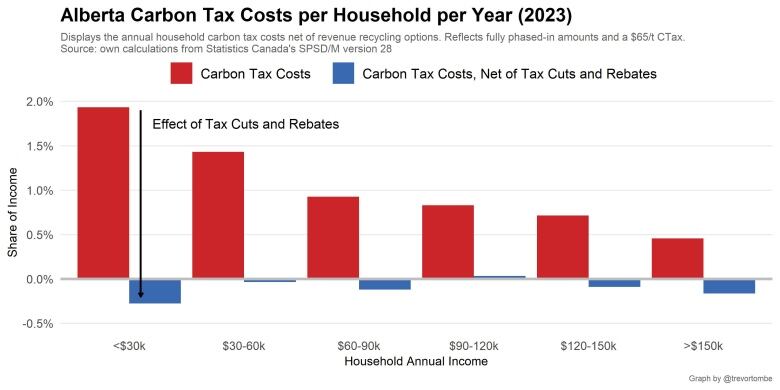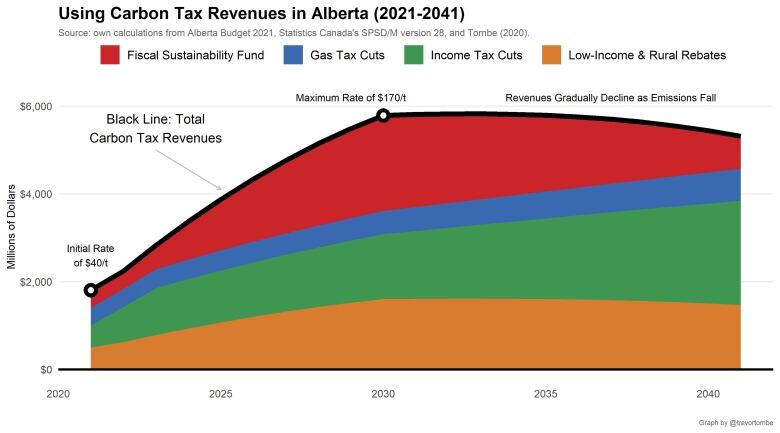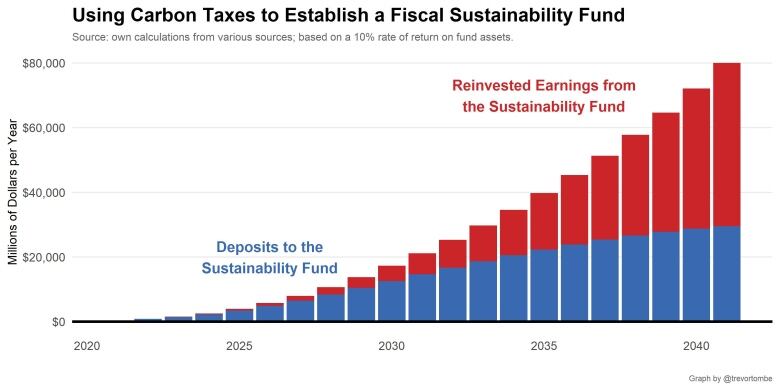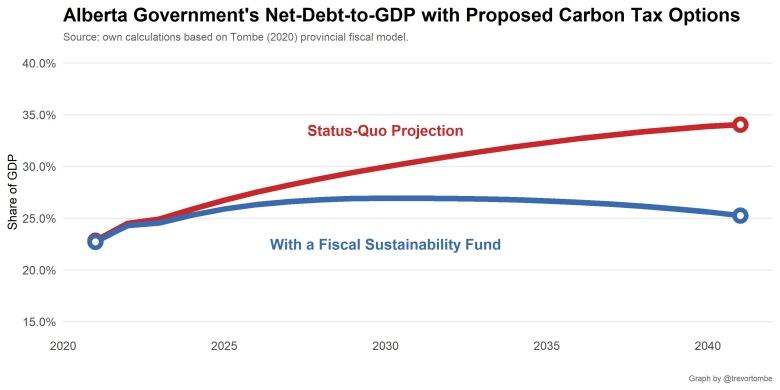How Alberta can benefit from a provincial carbon tax
Whatever your priorities, using carbon tax revenues to achieve them requires Alberta take back control

This column is an opinion from Trevor Tombe, an associate professor of economics at the University of Calgary. For more information aboutCBC's Opinion section, please see theFAQ.

Immediately after the Supreme Court of Canada ruled that the federal carbon tax is constitutional, Saskatchewan Premier Scott Moe pledged to implement a provincial version instead. From his perspective, if a carbon tax must exist, then the provincial government can better use the revenues.
Will Premier Jason Kenney do the same?
"I can't imagine that he wouldn't," said the Globe and Mail's Kelly Cryderman on the latest episode of the (fabulous) CBC podcast West of Centre.
The economic, fiscal and political benefits of taking back control of the carbon tax are substantial.
For 2021-22, carbon tax revenues in Alberta under the federal policy will exceed $1.8 billion. This is set to increase to over $2.2 billion once the tax reaches $50 per tonne in 2022, and to over $2.8 billion by 2023.
As I'll illustrate below, such revenues can provide Alberta with the fiscal room to cut other taxes, save resource revenuesand help rebuild provincial finances after COVID-19.
Whether you like the tax or not, these are options worth considering.
Using carbon tax revenues differently
Currently, the federal government rebates 90 per cent of carbon tax revenues back to households. It doesn't refund carbon taxes paid (a common misunderstanding) but instead provides a lump-sum amount to individuals when they file their income taxes. Rural residents get more, as do larger families, but otherwise it's fairly uniform and universal.
Instead, consider an alternative thatoffsets the average cost of carbon taxes for most households, but no more;achieves some fiscal/political objectives of the provincial government;andensures Alberta's finances are sustainable for years to come.
Specifically, here are some suggestions:
1. Provide low-income tax credits ($450 million in 2021, over $700 million by 2023)
Carbon taxes are regressive. Targeted cash transfers to lower income individuals and families can offset this. In 2021, $275 for an individual, $425 for a couple, plus $75 per child for those with individual incomes less than $50,000 or family incomes less than $80,000 will do the trick.
2. Rural and agricultural supports ($50 million in 2021, nearly $80 million by 2023)
Rural residents use more fuel than urban residents. Farmers also raise vocal concerns about carbon taxes. The government could provide rural top-ups and targeted agricultural support, perhaps on a per-acre basis for farmers and boosting rebate values by 10 to 20 per cent for rural residents.
3. Cut personal income taxes ($500 million in 2021, over $1 billion by 2023)
Carbon tax revenues can fund tax cuts elsewhere. British Columbia, for example, lowered both personal and corporate income taxes with its carbon tax revenues. Alberta has already lowered its corporate rate in recent years, so the case for additional cuts may be weaker. Instead, consider cutting the first bracket of personal income taxes by 0.5 points in 2021, 0.75 points in 2022, and a full point in 2023 onward. This would make the first-bracket income tax rate nine per cent instead of the current 10 per cent. All income tax payers would benefit, with roughly $300 per year for the average family.
4. Cut gas taxes ($400 million in 2021, gradually increasing thereafter)
Prince Edward Island, New Brunswick and Newfoundland and Labrador all lowered their gas taxes using carbon tax revenues. Saskatchewan appears certain to do so as well. This is contrary to the environmental objectives of the carbon tax, which explicitly aims to increase the price of emitting greenhouse gases from burning fossil fuels. But for some governments, the political calculation was that lower gas taxes help ease resistance to carbon taxes. Alberta's government would probably make the same judgment. Conveniently, its gasoline/diesel tax was recently increased four cents per litre in 2015, so I would consider reversing that and returning to a nine-cents-per-litre tax.
Without going into too much detail, these options almost fully offset the average cost of carbon taxes on households. Below I illustrate the situation in 2023, when the income tax cuts are fully phased-in. The carbon tax that year would cost lower-income households nearly two per cent of their annual income. Rebates offset that. For higher income households, the carbon tax costs are roughly 0.5 per cent of income. Income tax cuts offset that.

Of course, while this package is neutral across the income distribution, it is worse for most households than the current federal policy that distributes nearly all revenues back to households. The above options cost less, totalling $2.2 billion by 2023 out of over $2.8 billion in total carbon tax revenues. Over time, the excess revenues grow even larger.
What can Alberta do with these remaining revenues?
Establish a fiscal sustainability fund
It might be tempting to use revenues to shrink the deficit or repay debt, but there may be a better way.
Currently, borrowing rates are very low. Repaying debt would save on interest, but forgo the opportunity to earn more.
We could, for example, divert some resource revenues into the Heritage Fund and use carbon tax revenues to fill the gap. Or (equivalently) we could use carbon taxes directly to establish something I'll call a "Fiscal Sustainability Fund." Either way, the effect is the same: an increasing pool of savings and larger investment earnings.

And if earnings are reinvested (rather than spent, as we do with Heritage Fund), then the fund soon becomes an important financial asset to draw upon.
In my projection below (which is highly uncertain, to be sure, since investment returns are volatile), the fund could plausibly reach $80 billion by the early 2040s, generating annual earnings of seven to eight billion dollars per year. This converts a temporary source of revenues (the carbon tax) into a permanent one (investment income).
Gradually, earnings in the fund could be redirected to the general government budget to help fund public services. In the meantime, every dollar deposited into and earned by the fund can be tracked and reported on so Albertans know how carbon tax revenues are used.

This matters for Alberta's long-run financial health. A growing sustainability fund means shrinking debt levels falling by nearly 10 per cent by the early 2040s. This doesn't fully solve all of Alberta's financial challenges, but it does a lot of heavy lifting.

As the government is committed to planning for a return to balance and gradually decreasing provincial debt levels, carbon tax revenues should be a part of the solution.
Alberta's fiscal future
These are just a few of many potential choices available to Alberta. Some might prefer spending on environmental initiatives. Smaller tax cuts could fund that. Others might prefer smaller rebates and larger income tax reductions. That's possible too. And yet others might prefer using carbon tax revenues to shrink the deficit directly.
Whatever your priorities, using carbon tax revenues to achieve them is only possible if Alberta takes back control. We should do so immediately.
Do you have a strong opinion that could add insight, illuminate an issue in the news, or change how people think about an issue? We want to hear from you. Here'show to pitch to us.












_(720p).jpg)


 OFFICIAL HD MUSIC VIDEO.jpg)
.jpg)



























































































